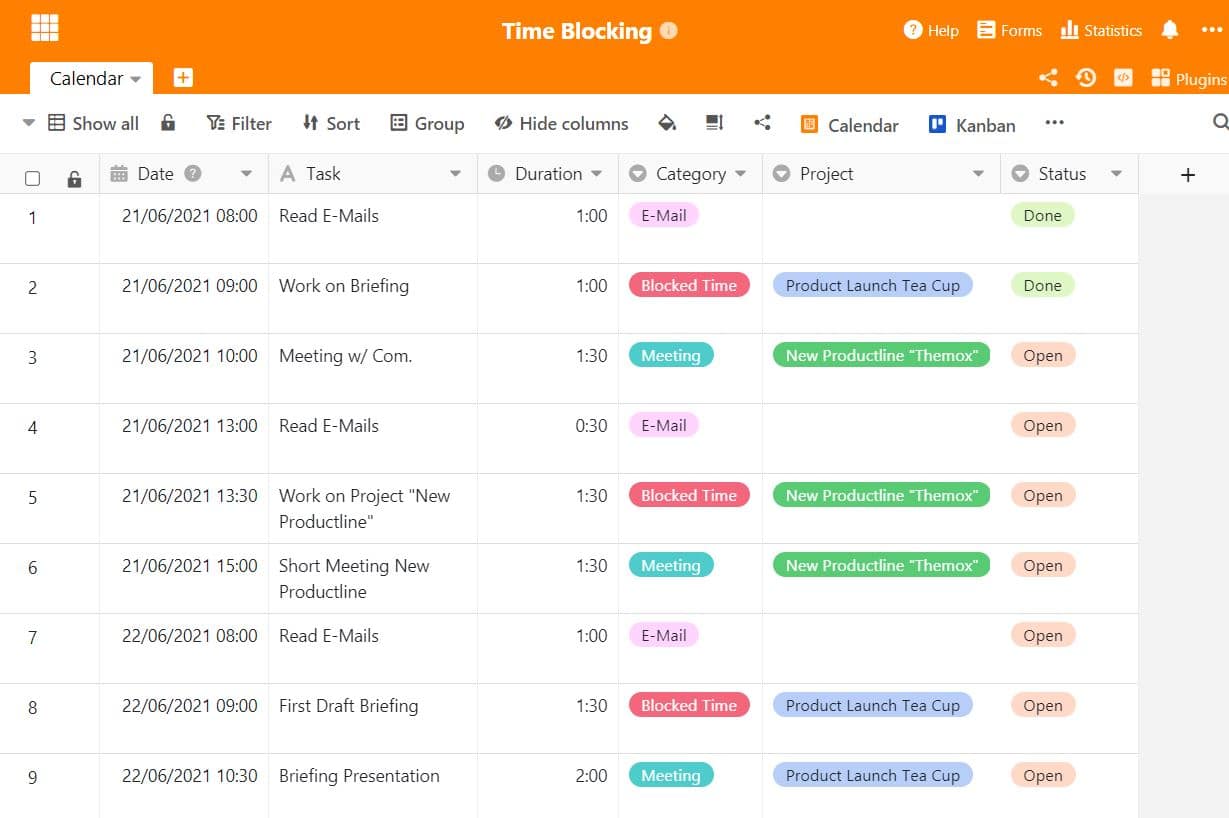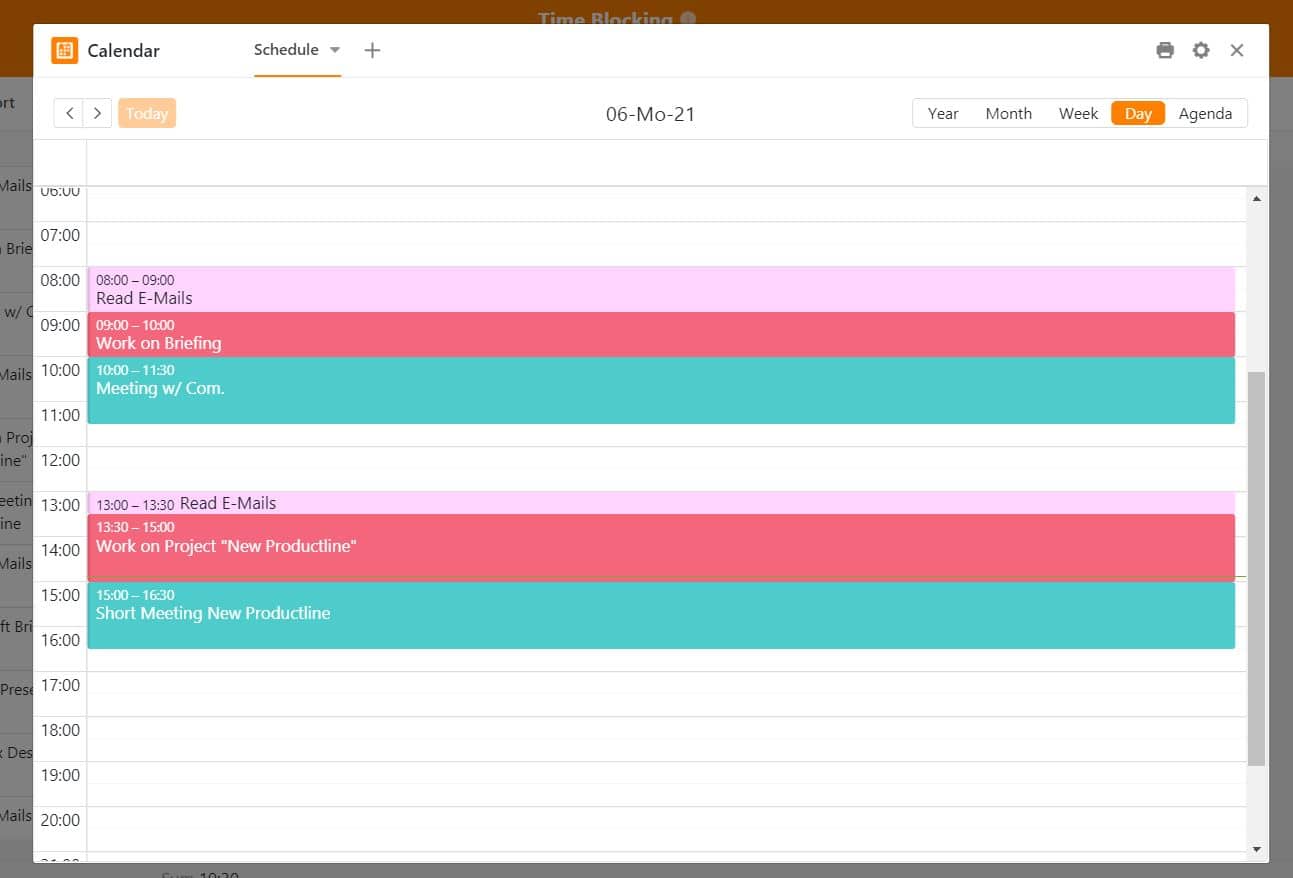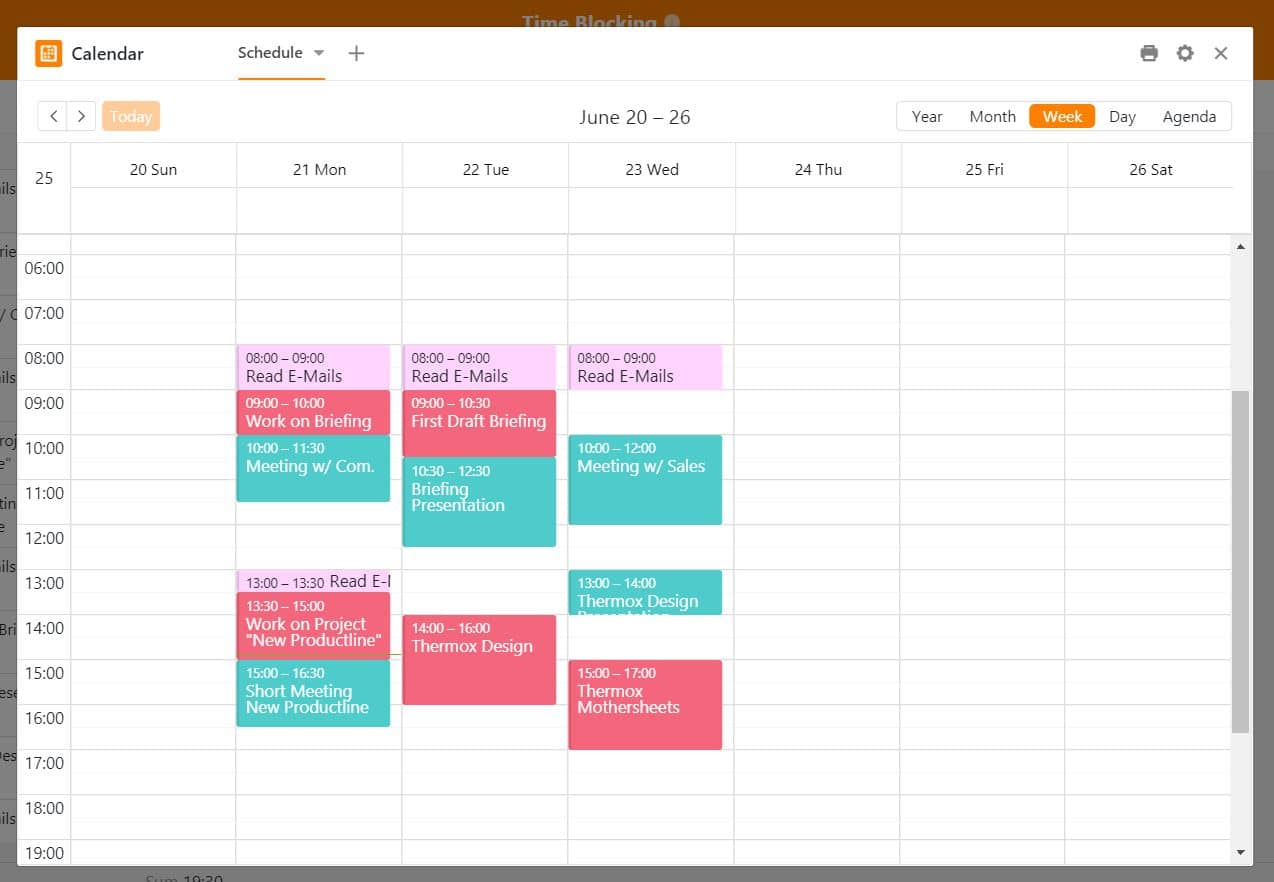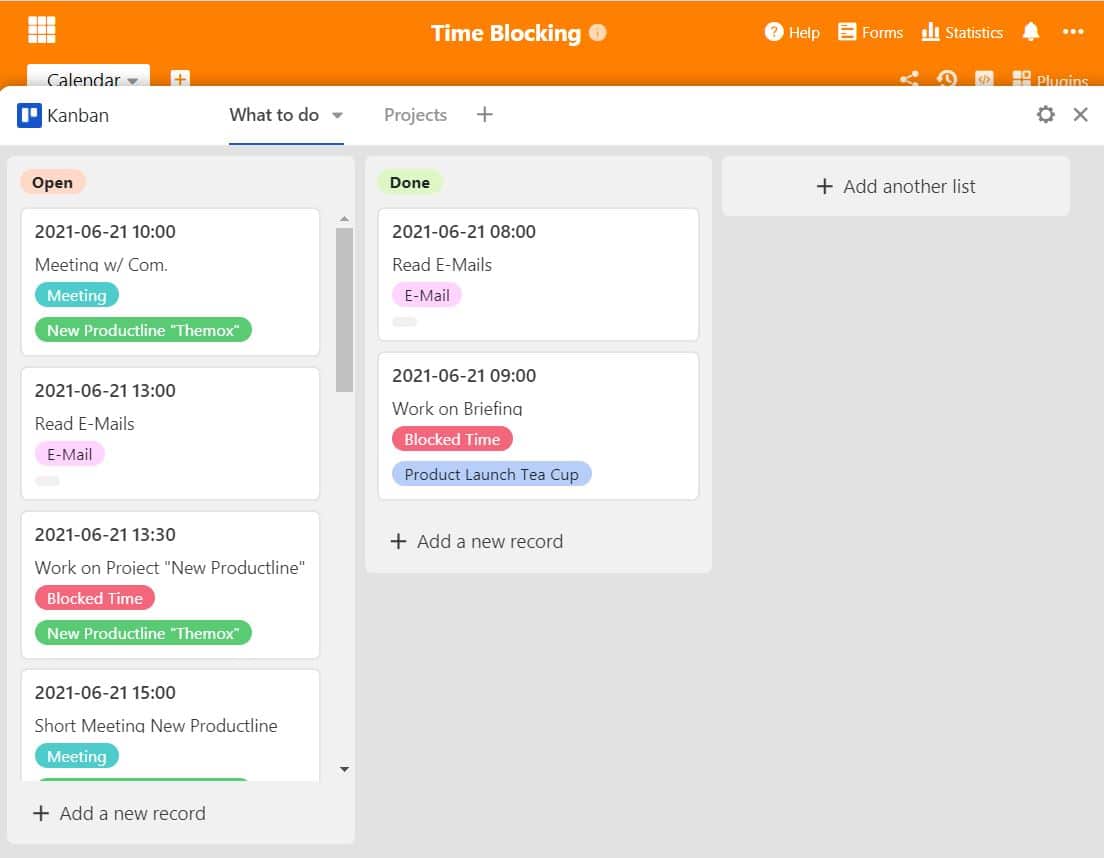Der Arbeitsalltag ist oft stressig und manchmal verläuft er einfach nicht so, wie man es sich am Morgen vorgestellt hatte. Ihre Pläne für den Tag wurden durch Telefonanrufe, Meetings und Emails völlig durcheinander gebracht und Sie fragen sich am Ende des Tages: Was habe ich eigentlich überhaupt geschafft? Damit solche Situationen nicht mehr entstehen, sollten Sie sich mit Time Blocking bekannt machen.
Was ist Time Blocking?
Die Time Blocking Methode ist eine Produktivitätstechnik, die für die Selbstorganisation und das eigene Zeitmanagement sehr effektiv sein kann. Bei dieser Methode wird der gesamte Arbeitstag in Zeitblöcke eingeteilt, die sich jeweils einem bestimmten Thema widmen. So strukturieren Sie Ihren ganzen Tag nach einem strikten Zeitplan, der durch nichts unterbrochen werden darf.
Ihre Aufgaben sollten Sie dabei priorisieren, damit wichtige Dinge zuerst erledigt werden. Durch das Planen von festen Zeitblöcken können Sie alle laufenden Projekte abdecken und vergessen keine To-Do’s mehr. Sie können mit Time Blocking auch ganz gezielt das Beantworten von Emails, das in der Regel unbewusst viel Zeit einnimmt, zeitlich einrahmen.
Wieso Time Blocking?
Arbeitsunterbrechungen gehören im Arbeitsalltag dazu – denn nicht jeder hat einen eigenen Büroraum, in dem er ungestört arbeiten kann. Insbesondere bei der Arbeit mit vielen Schnittstellen, wie etwa im Projektmanagement, sind Arbeitsunterbrechungen fast unvermeidbar. Anrufe, laute Umgebung und ad-hoc zugerufene Aufgaben sind in Großraumbüros keine Seltenheit.
Während des Arbeitsflusses ständig unterbrochen zu werden, hemmt aber die Produktivität deutlich. Auch Multitasking ist ein Produktivitätskiller, der sogar die Gesundheit belasten kann, wie eine Studie der BAuA herausfand. Die Arbeitsqualität verschlechtert sich, denn Sie kommen fast nie in den Zustand hoher Konzentration und Produktivität hat kaum eine Chance, überhaupt erst zu entstehen.
So muss die Konzentration nach einer Unterbrechung mühsam wieder aufgebaut werden. Das kann einige Zeit dauern. Wenn bis dahin wieder eine Unterbrechung besteht, baut sich auf Dauer keine hohe Konzentration auf und Unproduktivität ist die Folge. All das spricht für Time Blocking, denn die Methode blockiert alle Unterbrechungen von außen und sorgt für wirklich produktiv genutzte Arbeitszeit.
Time Blocking Varianten
Es gibt verschiedene Wege, Time Blocking in den Arbeitsalltag zu integrieren. Der klassische Weg ist das oben beschriebene Einrichten von Zeitblöcken für ganz bestimmte Aufgaben. Vielleicht gibt es für Sie und Ihre Arbeitsweise aber noch andere geeignete Methoden, die dem Time Blocking angehören. Je nachdem, welche Methode besser zu Ihnen passt, wird Ihr Arbeitsalltag eine ganz neue produktive Struktur finden.
Time Blocking: „Heute werde ich von 13 bis 14 Uhr Trendrecherchen durchführen, und von 14 bis 15 Uhr am Briefing weiterarbeiten“
Das ist das klassische Time Blocking, das Sie im besten Fall in Ihren persönlichen Kalender integrieren können. So stehen nicht nur fixe Meetings und Termine darin, sondern Sie haben Ihre komplette Tagesplanung visuell geplant. Das Aufschreiben und Festlegen von Zeitblöcken gibt Ihnen nicht nur eine bessere Übersicht über aktuelle Projekte, sondern stellt auch sicher, dass Sie mit Ihrer Zeit vorsichtiger und bewusster umgehen. Das Festlegen von festen Uhrzeiten verhindert, dass Sie bei Ihren Tätigkeiten ständig unterbrochen werden und Ihre Konzentration schmälert.
Aufgaben Batching: „Von 10 bis 11.30 Uhr werde ich alle meine Emails durcharbeiten und beantworten“
Das Aufgaben Batching konzentriert sich darauf, kleinere und ähnliche Aufgaben in einem Zeitblock zu erledigen. Dazu gehört zum Beispiel das Beantworten von Emails, das Bearbeiten von Bildern oder Besorgungen erledigen. Wichtig ist hierbei, den Kontextwechsel so gering wie möglich zu halten, dazu kann zum Beispiel auch schon das Wechseln zu einem anderen Programm gehören. Bleibt alles in einer Umgebung, so kann sich ganz der Aufgabe gewidmet werden und die kleinen Einheiten werden nach und nach abgehakt.
Tagesthemen: „Montags werde ich mich immer um die Markt- und Konkurrenzrecherchen kümmern, Dienstags konzentriere ich mich auf die Berichterstattung über unsere Produkte“
Es kann auch helfen, ganze Wochentage nach bestimmten Themen zu planen. Das kann funktionieren, wenn man mehrere Aufgabenbereiche verantwortet und betreut, wie etwa Marketing, Vertrieb oder Personal. Um dabei in jedem Bereich informiert zu sein und auf wichtige Themen reagieren zu können, ist es ratsam, Meetings dieser Bereiche nicht auf den selben Tag zu legen, sondern ihnen separate Tage zuzuordnen. So kann sich davor mit neuen Erkenntnissen, Fragen, Problemen oder Neuigkeiten beschäftigt werden und danach mit den Ergebnissen des Meetings gearbeitet werden. Das thematische Aufteilen auf verschiedene Tage reduziert den Kontextwechsel und gibt mental klarere Strukturen.
Time Boxing: „Heute werde ich von 12 bis 13 Uhr das Briefing fertigstellen“
Time Boxing und Time Blocking werden zwar oft als Synonyme genutzt, jedoch konzentriert sich das Time Boxing auf das zeitliche Einteilen mithilfe einer Deadline. Es werden also wie beim Time Blocking Zeitblöcke festgelegt, in denen bestimmte Aufgaben bearbeitet werden, nur wird beim Time Boxing noch die Prämisse gesetzt, mit den Aufgaben auch fertig zu werden. Der Zeitdruck wirkt manchmal Wunder und fordert Sie dazu heraus, effizient und produktiv an Aufgaben zu arbeiten.
Warum ist Time Blocking so effektiv?
Time Blocking ist nur aus einer guten Planung der Aufgaben heraus möglich. Sie müssen sich gezielt mit der kommenden Tagesplanung auseinander setzen und können so am nächsten Tag Ihre ganze Aufmerksamkeit auf den anstehenden Block richten. Das Fokussieren und nicht-mehr-ablenken-lassen muss trainiert werden, denn direkt in eine hohe Konzentration zu kommen, ist in ungeübter Form schwierig. Das Einteilen der Arbeitszeit kann Ihnen dabei helfen. Dabei hat es noch weitere Vorteile:
- Time Blocking macht Ihnen bewusst, wie Sie Ihre tägliche Arbeitszeit verbringen
- Kein Platz für unnötigen Perfektionismus
- Sie definieren und erreichen Ziele effizienter und besser
Fangen Sie einfach mal an, Ihren Tagesablauf zu strukturieren. Es mag anfangs noch schwer fallen, aber die Vorteile werden dabei bald überwiegen. Sie können Time Blocking dabei nicht nur mit einem digitalen Kalender in Ihrem Email-Konto oder auf Ihrem Smartphone einsetzen, sondern auch ganz klassisch eine Zeitplanung auf Papier verfassen. Das kann bei der Visualisierung helfen.
Time Blocking mit SeaTable
Falls Sie doch lieber eine digitale Zeitplanung bevorzugen, können Sie diese mit SeaTable mit wenigen Schritten umsetzen. Dabei spielen nicht nur die verschiedenen Spaltentypen eine große Rolle, sondern auch die extrem starken Plugins eröffnen bei der Nutzung mit SeaTable ganz neue Möglichkeiten. Mit einer SeaTable-Tagesplanung schaffen Sie sich die besten Voraussetzungen für ein erfolgreiches Time Blocking, das etwa so aussehen könnte:

SeaTable bringt als starke Software die Vorteile eines Spreadsheets und einer Datenbank in einem Produkt mit sich. Sie können eine Vielzahl an Daten sammeln, ordnen und für Sie selbst aufbereiten. Sie können Daten aber auch mit Ihrem Team und anderen Beteiligten teilen und in Echtzeit synchronisieren. Ihre eigene SeaTable-Tagesplanung können Sie so nicht nur für Sie selbst aufbereiten, sondern auch Ansichten für Kollegen freischalten – die so ganz genau wissen, wann Sie Zeiten für sich selbst geblockt haben und Sie nicht verfügbar sind.
Time Blocking mit Calendar Plugin
Mit der Datums-Spaltenfunktion lassen sich ganz einfach kalendarische Übersichten erstellen, die ganz auf Ihre Bedürfnisse angepasst sind. Damit ist eine Organisation von Terminen und der Tagesplanung tabellarisch möglich, sodass kein separates Nutzen von Kalendern mehr nötig ist. Mit dem Calendar Plugin können Sie Termine und Daten in Kalenderform darstellen und sehen so in einem Blick, welche Termine und Aufgaben für den heutigen Tag, die Woche, den ganzen Monat oder das Jahr anstehen.


Mit dem Calendar Plugin lassen sich jegliche Arten von Events und Terminen visuell darstellen und können auch farblichen Schemata zugeordnet werden. So haben Sie eine direkte Übersicht über Ihre gesamte Planung und können Time Blocking ganz gezielt in Ihren Tag integrieren. Mit rot gefärbten Zeitslots sind geblockte Zeiten direkt für Sie und andere Mitarbeiter sichtbar – in dieser Zeit sind Sie quasi “not available”.
Time Blocking mit Kanban Plugin: So haben Sie Ihre Aufgaben im Blick
Mit dem neuen Kanban Plugin ist es möglich, Aufgaben und Projekte im Trello-Stil abzubilden. Diese Funktion ist besonders für die visuelle Darstellung von Themen und To Do’s extrem wertvoll und hilft Ihnen dabei, Ihren Workflow effizient zu gestalten. Das Kanban-Board greift dabei auf Daten in der SeaTable Tabelle zurück. Die Kategorien werden aus den verschiedenen Spalten kreiert, wie etwa der Einfachauswahl-Spalte. Somit lässt sich das Board hochflexibel in den verschiedensten Bereichen anwenden und es kann gänzlich auf externe Lösungen wie Trello verzichtet werden.

Wie von Kanban-Tools gewohnt, können Sie die einzelnen Aufgaben per Drag-and-Drop verschieben und so den Status aktualisieren. Dies gibt Ihrem Tagesablauf eine klar vordefinierte Struktur. Praktischerweise wird die zeitlich als nächstes anstehende Aufgabe ganz oben angezeigt, sodass Sie mit Ihrem Zeitplan immer auf dem neuesten Stand sind. Sie können auch hier weitere Boards erstellen, die auf verschiedenen Ansichten beruhen und sich etwa nur auf projektbezogene Aufgaben konzentrieren. Dabei können neue Einträge direkt im Kanban-Board erstellt werden.
Somit haben Sie nicht nur das Time Blocking mit dem Calendar Plugin effektiv in Ihren Tagesablauf integriert, sondern auch das Kanban Plugin sinnvoll in Ihre Aufgabenverwaltung einfließen lassen. Das hat sogleich eine doppelte Effizienzsteigerung zufolge: Sie halten sich strikt an Ihre Produktivitätsphasen und können damit gleichzeitig Ihre Aufgaben überwachen und Ihre Fortschritte dokumentieren.
Starten Sie mit SeaTable noch heute für Ihren Produktivitätsboost!

